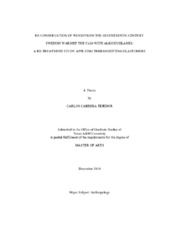| dc.description.abstract | The purpose of this study was to explore the feasibility of re-treating artifacts
previously conserved by PEG impregnation with alkoxysilanes. The study tried to
evaluate pros and cons of re-conserving artifacts with this type of silanes. A series of
experiments were conducted focusing on small, wood samples from the Vasa Museum
Collection, to test different re-conservation methods. Three different procedures
involving alkoxysilanes were implemented in order to re-conserve the samples.
The study revealed the techniques are an efficient re-conservation method in
which highly satisfactory results can be achieved. The re-treated samples present
minimal volumetric distortion without significant collapse or shrinkage of the wood
structures. This minimal distortion is primarily produced by the transition from swollen
waterlogged wood to a dry conserved wood, and not as a result of collapse or shrinkage
during treatment. Due to the negligible thickness of the polymer coating (a few microns),
the samples acquire physical properties extremely close to the original dry wood.
Moreover, other physiochemical properties are obtained from the consolidation
with alkoxysilanes; the re-conserved wood becomes hydrophobic, chemically inert,
resistant to chemical attacks (e.g., acids or bases), and resistant to ultraviolet light. These
newly acquired characteristics drastically reduce the preventive conservation measures
needed in museum display cabinets or during transport.
Despite the excellent results, the procedure is not reversible, thus does not
comply with one of the main premises traditionally accepted in conservation. Therefore,
a careful study assessing benefits and disadvantages in a case-by-case basis should be
assessed by conservators, restorers, and curators before applying this method to
waterlogged material culture. | en |


